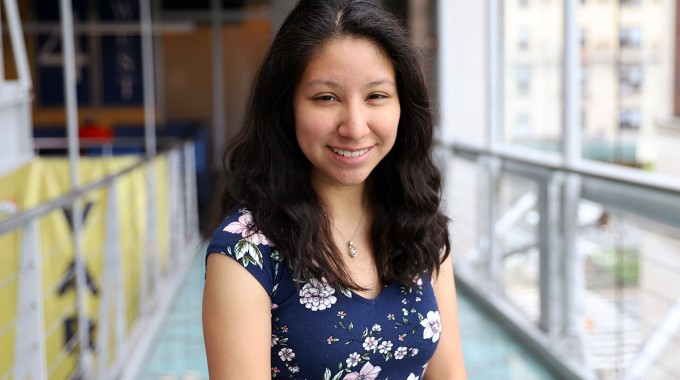If you know of a Columbia College student, faculty member, alumnus/alumna or program we should spotlight, or if you would like to submit a story, please contact:
Columbia College
Office of Communications
cc-comms@columbia.edu

“I’m always learning here whether it is in the classroom or having a conversation over dinner with friends who are totally different than me...it’s part of making the most of everything that is the Columbia and New York experience.”—Sofia Schembari CC’19
Sofia Schembari CC’19 grew up in the Pocono Mountain region of Pennsylvania and became an emergency medical technician when she was 16. So it’s not totally surprising that she didn’t panic while making her way on foot through mud in a tropical rainforest just to get to her summer research project.
Schembari flew through Nairobi, Kenya where she took a domestic flight to Kisimu, Kenya for what she thought was the final leg en route to the Kakamega Rainforest. She’d already connected with a taxi driver her professor knew. “We stopped at a grocery store to get supplies — mosquito net and mud boots — and then we drove to the forest” she said. “This was my first time being in Africa, right in the middle of the rainforest, not even in a town.”
It rains practically daily in Kakamega. Schembari and the driver found the road to the research station full of mud. “The car couldn’t even get through. He pulled over, not that it mattered as there weren’t any other cars, and we had to walk the rest of the way. I had a box of groceries, my backpack and my suitcase. That was my first experience in Kenya.”
Other than the research team, the Kakamega Rainforest’s only human inhabitants are Kenyan forest guards and their families. The other significant population are “Old World” primates, characterized by white markings or bright colors, such as the blue monkeys Schembari was to focus on for the next 10 weeks.
“I was prepared for all those things — I’m from the country, so I have been in a forest around wild animals before — but being around wild monkeys…. When I graduated high school I wouldn’t have expected ‘I’m going to go to the rainforest and follow monkeys,’” she reflected.
By the end of the summer, the evolutionary biology major had contributed data to scientific discoveries about the blue monkeys that are 40 years in the making. She also added to her own research.
“I study monkey sex,” she says. “There’s a little bit of a shock response to it, but it launches conversations that I think are important to have.”
Specifically, Schembari is researching the possible reasons for adult female blue monkeys’ promiscuity, a category that includes exchanging sex for grooming, intrasexual competition, and, most convincing to Schembari, infanticide avoidance. The field study helped inform her senior thesis and will be research she continues after graduation, this time in Costa Rica.
“I didn’t know the [evolutionary biology of the human species] major existed until I took science sophomore year,” she says, crediting her advisor, Jill Shapiro, senior lecturer in the discipline of ecology, evolution and environmental biology, as “one of the best parts of my time at Columbia.” Her opportunity to go to Kenya evolved from an exploratory conversation about field research with Professor of Anthropology Marina Cords, after which “everything was falling into place pretty quickly.”
Schembari’s journey to Columbia College also materialized pretty quickly. She knew she wanted to attend college in New York, and says that after Days on Campus — a weekend when prospective students visit campus — she felt “this feeling of you get there and you know it’s where you want to be. I could really see myself in this place with people that are similar to me and that are wildly different — people I could see being friends with for the next however many years.”
In addition to friends, the last several years have brought Schembari many highlights. She’s worked at and gotten to be a visiting scientist at the American Museum of Natural History, talking to kids about her days in the forest — “I thought to apply there because of a frontiers of science lecture about dinosaurs,” she says. She has also served as a mentor to a young woman in Harlem through the Big SIBS program with Columbia Community Impact (“Being able to just be in a person’s life for four years is very rewarding.”) and helped high school and younger students understand what it’s like to apply to college and be at Columbia through her work with Undergraduate Admissions’ Multicultural Recruitment Committee, for which she served as co-chair her senior year.
“There’s so many opportunities here but a lot of times they don’t come out and find you; a lot of them you have to go look for,” Schembari says. She encourages “talking to people who are doing things you’re interested in whether it’s academic or service.”
“I’m always learning here whether it is in the classroom or having a conversation over dinner with friends who are totally different than me,” she says. “It’s part of making the most of everything that is the Columbia and New York experience.”